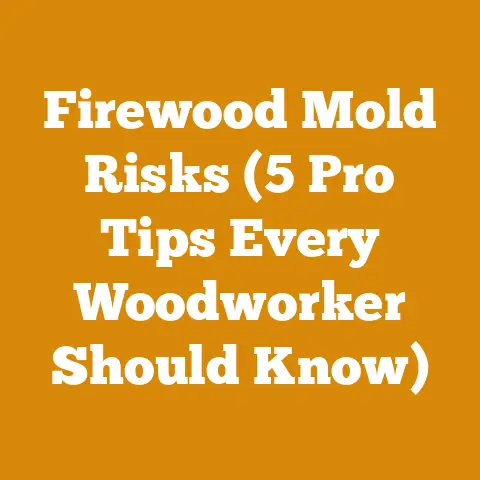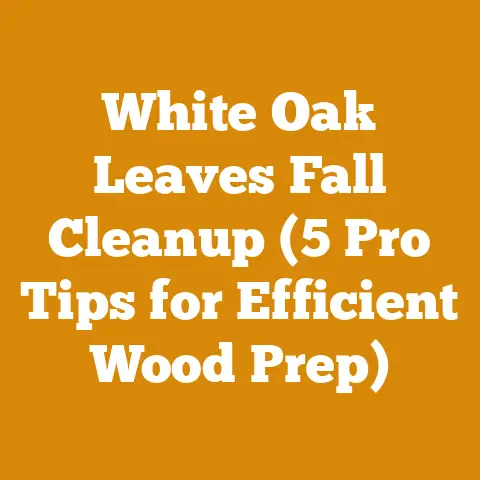Wood Stove Insert vs Wood Stove (5 Expert Tips for Best Heat)
I once made a mistake that nearly cost me a winter’s worth of heat, and it’s what fuels my passion for sharing accurate information about wood stoves and wood stove inserts. I assumed that any old stove would do, slapped it into my hearth, and called it a day. Big mistake. The house filled with smoke, the efficiency was abysmal, and I spent more time fiddling with the damper than enjoying the warmth. That’s when I realized the devil is in the details, and understanding the nuances between a wood stove and a wood stove insert can make or break your heating season.
So, let’s dive into the nitty-gritty of wood stoves versus wood stove inserts, exploring five expert tips to maximize heat output and efficiency, all based on years of hands-on experience and a whole lot of trial and error.
Wood Stove vs. Wood Stove Insert: 5 Expert Tips for Best Heat
1. Understanding the Core Differences: A Technical Breakdown
Before we get to the tips, let’s lay the groundwork. A wood stove is a freestanding appliance designed to sit out in the open, radiating heat in all directions. A wood stove insert, on the other hand, is designed to slide into an existing fireplace, transforming an open hearth into a more efficient heating source.
Wood Stove:
- Installation: Freestanding; requires proper clearances from combustible materials.
- Heat Output: Radiates heat in all directions; good for heating larger, open spaces.
- Efficiency: Varies; newer models are significantly more efficient than older ones. Look for EPA-certified stoves.
- Cost: Generally lower upfront cost than inserts.
- Chimney Requirements: Requires a dedicated chimney system.
Wood Stove Insert:
- Installation: Slides into an existing fireplace; requires a properly sized and lined chimney.
- Heat Output: Directs heat forward; good for heating specific areas. Many include blowers to circulate air.
- Efficiency: Typically more efficient than an open fireplace; EPA-certified models offer optimal performance.
- Cost: Higher upfront cost than wood stoves, but can be offset by increased efficiency and reduced fuel consumption.
- Chimney Requirements: Requires a stainless steel liner to be run up the existing chimney.
Technical Specifications Comparison:
| Feature | Wood Stove | Wood Stove Insert |
|---|---|---|
| Placement | Freestanding | Existing Fireplace |
| Heat Distribution | Radiant, Convection (some models) | Radiant, Convection (most models with blowers) |
| Efficiency (EPA) | 60-80% (modern stoves) | 70-85% (modern inserts) |
| Fuel Type | Seasoned Hardwood | Seasoned Hardwood |
| Chimney | Dedicated Class A Chimney | Stainless Steel Liner |
| Clearance to Combustibles | Varies by model; typically 36″ sides, 48″ front | Varies by model; follow manufacturer guidelines |
| BTU Output | 30,000 – 80,000 BTU/hr | 40,000 – 70,000 BTU/hr |
2. Matching the Stove to Your Space: BTU Calculations and Room Size
One of the biggest mistakes I see people make is choosing a stove or insert that’s either too big or too small for their space. An oversized stove will run inefficiently and create uncomfortable heat, while an undersized stove will struggle to keep the room warm on cold days.
Calculating BTU Needs:
The amount of heat your space needs is measured in British Thermal Units (BTUs). As a rule of thumb, you need approximately 5,000 BTUs per 250 square feet of living space in a moderately insulated home. However, this is just a starting point. Several factors can influence your BTU requirements, including:
- Climate: Colder climates require more BTUs.
- Insulation: Poorly insulated homes require more BTUs.
- Ceiling Height: Higher ceilings require more BTUs.
- Window Area: Large window areas increase heat loss.
Formula:
- Calculate Square Footage: Measure the length and width of the area you want to heat and multiply them together.
Square Footage = Length (ft) x Width (ft) -
Determine BTU Factor: Use the following table as a guide:
Insulation Level Climate BTU Factor (BTU/sq ft) Good Mild 20 Good Moderate 25 Good Cold 30 Average Mild 25 Average Moderate 30 Average Cold 35 Poor Mild 30 Poor Moderate 35 Poor Cold 40 3. Calculate Total BTU Needs: Multiply the square footage by the BTU factor. Total BTU Needs = Square Footage x BTU Factor
Example:
Let’s say I want to heat a 500 square foot room in a moderate climate with average insulation.
- Square Footage = 500 sq ft
- BTU Factor = 30 BTU/sq ft
- Total BTU Needs = 500 sq ft x 30 BTU/sq ft = 15,000 BTUs
Therefore, I would need a stove or insert with a BTU output of around 15,000 BTUs.
Case Study: My Cabin Renovation
I renovated a small cabin in the mountains, and initially, I underestimated the BTU requirements. The cabin was only 600 square feet, but it had poor insulation and single-pane windows. I installed a small, 20,000 BTU wood stove, thinking it would be sufficient. However, on the coldest nights, the stove struggled to keep the cabin warm. I ended up adding extra insulation and sealing air leaks, which significantly improved the stove’s performance. This experience taught me the importance of considering all factors when calculating BTU needs.
3. Fuel Selection: Seasoned Hardwood is King (and Why)
The type of wood you burn has a massive impact on heat output and efficiency. Seasoned hardwood is the gold standard for wood stoves and inserts.
Why Seasoned Hardwood?
- Higher BTU Content: Hardwoods like oak, maple, beech, and ash contain more energy per unit volume than softwoods like pine, fir, and spruce.
- Lower Moisture Content: Seasoned wood has a moisture content of 20% or less, which allows it to burn hotter and cleaner.
- Less Creosote Buildup: Burning dry wood reduces the formation of creosote, a flammable substance that can accumulate in the chimney and cause chimney fires.
Moisture Content Matters:
- Green Wood (Unseasoned): 50-100% moisture content. Burns poorly, produces lots of smoke, and creates excessive creosote.
- Seasoned Wood: 15-20% moisture content. Burns efficiently, produces less smoke, and minimizes creosote buildup.
Measuring Moisture Content:
I highly recommend investing in a wood moisture meter. These inexpensive devices measure the moisture content of wood quickly and accurately.
How to Season Wood:
- Split the Wood: Splitting wood increases its surface area, allowing it to dry faster.
- Stack the Wood: Stack the wood off the ground in a single row, allowing air to circulate freely.
- Protect from Rain and Snow: Cover the top of the woodpile with a tarp or shed roof to prevent it from getting wet.
- Wait Patiently: Seasoning wood takes time, typically 6-12 months, depending on the climate and wood species.
Data Point:
- Oak (Seasoned): Approximately 25 million BTU per cord
- Pine (Seasoned): Approximately 15 million BTU per cord
My Wood Stacking Strategy:
Over the years, I’ve refined my wood stacking process to maximize drying efficiency. I use pallets to keep the wood off the ground, and I stack the wood in a crisscross pattern to promote airflow. I also orient the woodpile to take advantage of prevailing winds and sunlight.
4. Proper Installation and Chimney Maintenance: Safety First
Proper installation and regular chimney maintenance are crucial for safe and efficient operation. This isn’t an area to cut corners.
Wood Stove Installation:
- Clearances: Maintain proper clearances from combustible materials, as specified by the manufacturer. Typically, this means at least 36 inches from the sides and 48 inches from the front.
- Floor Protection: Place the stove on a non-combustible floor protector, such as fire-rated tile or sheet metal.
- Chimney Connection: Connect the stove to a properly sized and installed chimney.
- Professional Installation: Consider hiring a qualified professional to install the stove, especially if you are not experienced in this type of work.
Wood Stove Insert Installation:
- Chimney Liner: Install a stainless steel chimney liner that is sized to match the insert. This is essential for safe and efficient operation.
- Sealing: Seal the insert to the fireplace opening to prevent air leaks.
- Electrical Connection: If the insert has a blower, make sure it is properly connected to a dedicated electrical circuit.
- Professional Installation: I strongly recommend hiring a certified installer for wood stove inserts. They have the expertise to ensure the installation meets local codes and safety standards.
Chimney Maintenance:
- Regular Inspections: Inspect the chimney at least once a year, preferably before the heating season begins.
- Chimney Sweeping: Clean the chimney regularly to remove creosote buildup. The frequency of cleaning depends on the type of wood you burn and how often you use the stove. I personally sweep my chimney every year.
- Professional Chimney Sweep: Consider hiring a professional chimney sweep to inspect and clean the chimney. They have the tools and expertise to do the job safely and effectively.
Safety Codes and Standards:
- NFPA 211: Standard for Chimneys, Fireplaces, Vents, and Solid Fuel-Burning Appliances. This standard provides detailed requirements for the installation and maintenance of wood stoves and chimneys.
- Local Building Codes: Check with your local building department for specific requirements and permits.
Unique Insight: The Importance of Draft
One aspect of chimney performance often overlooked is the draft. A good draft is essential for proper combustion and smoke evacuation. Factors affecting draft include chimney height, diameter, and temperature. A chimney that is too short or too wide will have a weak draft, while a chimney that is too tall or too narrow will have an excessive draft. I once had a situation where my chimney draft was too strong, causing the stove to burn fuel too quickly. I installed a barometric damper to regulate the draft and improve efficiency.
5. Optimizing Stove Operation: Burning Techniques and Air Control
Even the best stove won’t perform well if it’s not operated correctly. Mastering proper burning techniques and understanding air control are key to maximizing heat output and efficiency.
Burning Techniques:
- Top-Down Burning: This method involves lighting the fire from the top and allowing it to burn downwards. It produces less smoke and more consistent heat.
- Conventional Burning: This method involves lighting the fire from the bottom and adding wood as needed. It’s a simpler method, but it can produce more smoke.
- Hot and Fast vs. Slow and Steady: Burning the stove hot and fast produces more heat quickly, but it also consumes fuel faster. Burning the stove slow and steady provides more consistent heat over a longer period.
Air Control:
- Primary Air: Controls the amount of air entering the firebox from below. Adjusting the primary air controls the intensity of the fire.
- Secondary Air: Introduces air into the firebox above the fuel, which helps to burn off smoke and gases.
- Damper Control: Adjusts the airflow through the chimney. Closing the damper too much can cause smoke to back up into the room, while opening it too much can reduce efficiency.
Best Practices for Efficient Burning:
- Start with a Hot Bed of Coals: A hot bed of coals provides a stable base for the fire.
- Load Wood Properly: Load wood in a way that allows air to circulate freely. Don’t overload the stove.
- Adjust Air Controls: Adjust the air controls to maintain a clean, efficient burn.
- Monitor Chimney Temperature: Use a magnetic thermometer to monitor the chimney temperature. This can help you avoid overfiring the stove.
Data Point:
- Optimal Chimney Temperature: 250-450°F (121-232°C)
My Story: The Importance of Air Control
When I first started using wood stoves, I didn’t fully understand the importance of air control. I would often leave the air controls wide open, which caused the stove to burn fuel too quickly and produce excessive heat. I also didn’t realize the importance of secondary air. Once I learned how to properly adjust the air controls, I was able to significantly improve the stove’s efficiency and reduce smoke output.
Additional Tips and Considerations
- EPA Certification: Look for EPA-certified stoves and inserts. These models are designed to burn cleaner and more efficiently.
- Blower Fans: Consider a stove or insert with a blower fan. Blower fans help to circulate heat more effectively.
- Thermostatic Control: Some stoves and inserts have thermostatic controls, which automatically adjust the air supply to maintain a consistent temperature.
- Ash Removal: Remove ash regularly to maintain proper airflow.
- Door Gasket: Inspect the door gasket regularly and replace it if it is damaged. A worn gasket can cause air leaks and reduce efficiency.
- Creosote Buildup: Be vigilant about creosote buildup in the chimney. Regular chimney sweeping is essential for preventing chimney fires.
Limitations and Challenges
- Sourcing Quality Wood: Finding a reliable source of seasoned hardwood can be challenging, especially in urban areas.
- Storage Space: Storing a sufficient supply of wood requires adequate space.
- Manual Labor: Burning wood requires manual labor, including cutting, splitting, and stacking wood.
- Air Quality Regulations: Some areas have air quality regulations that restrict the use of wood stoves.
Conclusion
Choosing between a wood stove and a wood stove insert depends on your specific needs and circumstances. By understanding the core differences, calculating your BTU needs, selecting the right fuel, ensuring proper installation and maintenance, and optimizing stove operation, you can maximize heat output and efficiency. Remember, safety should always be your top priority. By following these expert tips, you can enjoy the warmth and comfort of a wood-burning stove or insert for many years to come.
Final Thoughts






